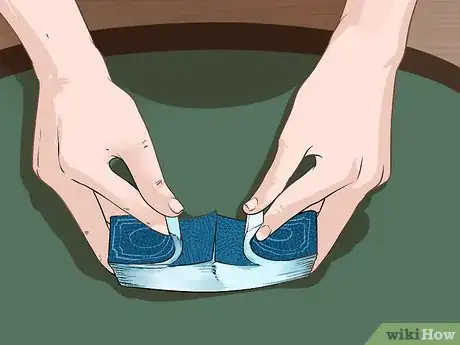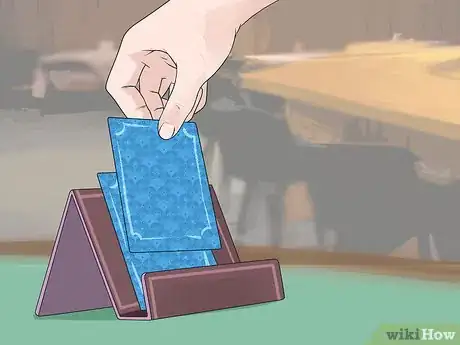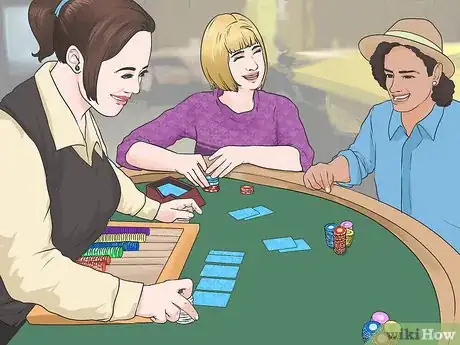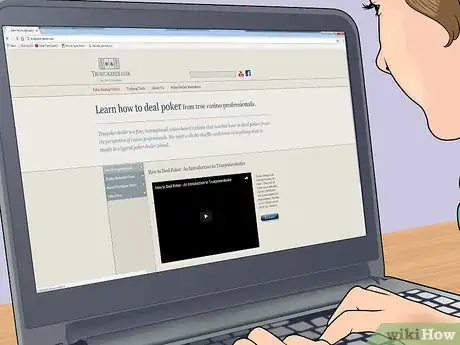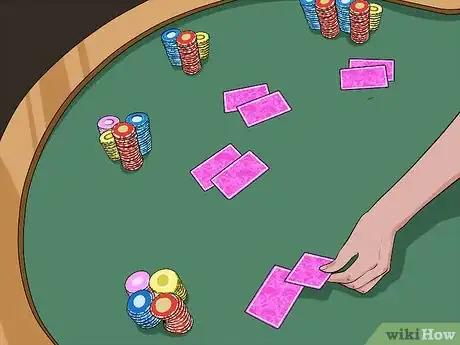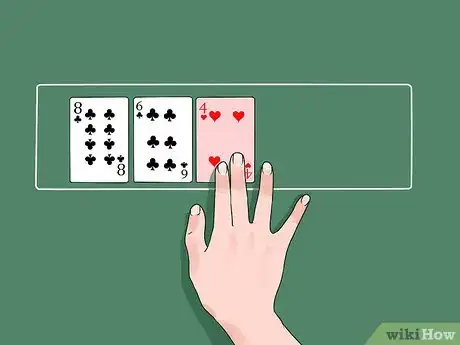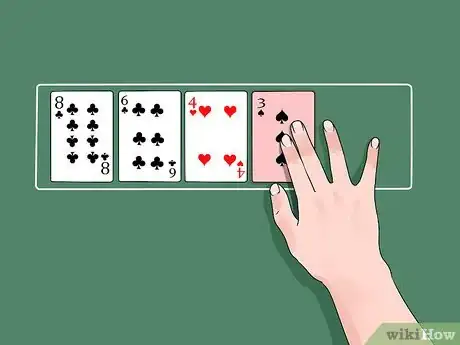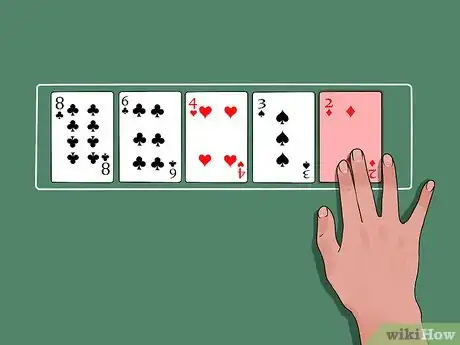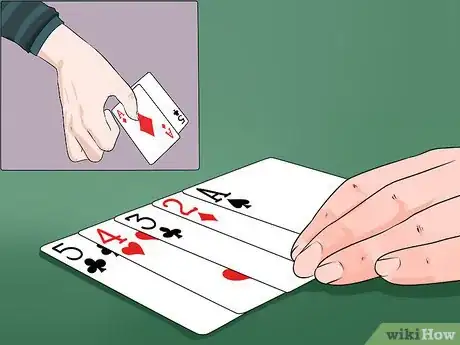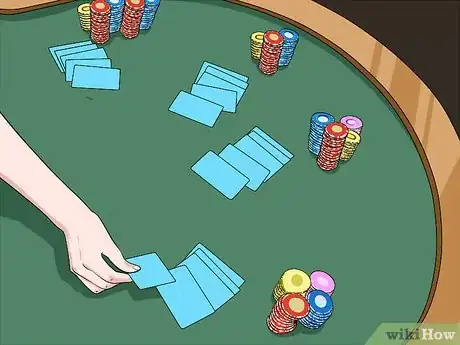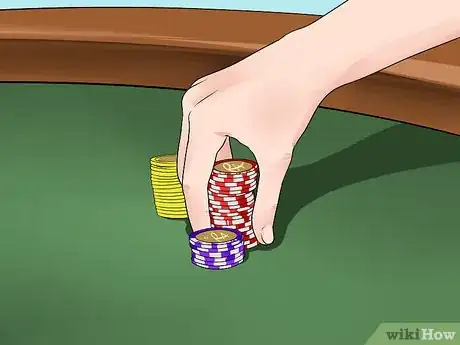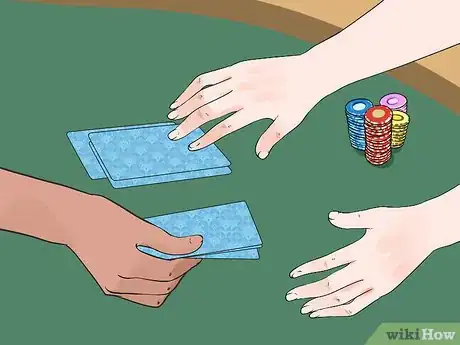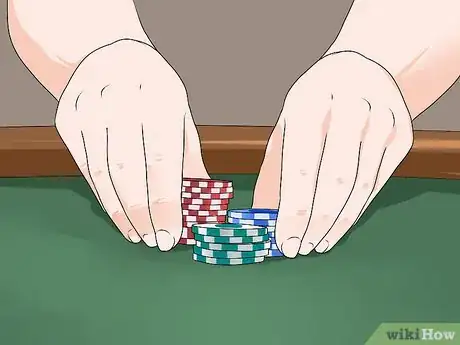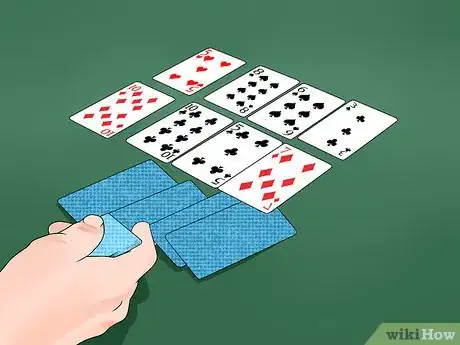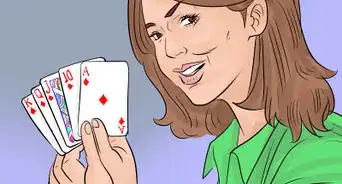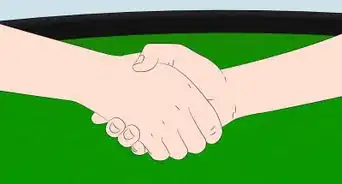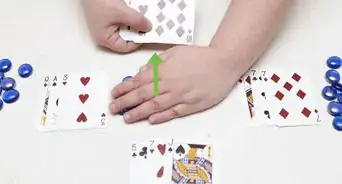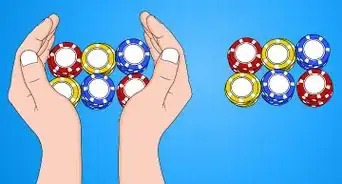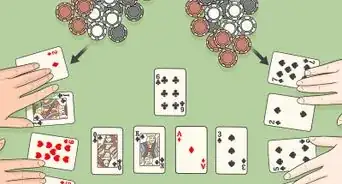This article was co-authored by wikiHow Staff. Our trained team of editors and researchers validate articles for accuracy and comprehensiveness. wikiHow's Content Management Team carefully monitors the work from our editorial staff to ensure that each article is backed by trusted research and meets our high quality standards.
There are 11 references cited in this article, which can be found at the bottom of the page.
This article has been viewed 134,113 times.
Learn more...
Poker is a popular game with multiple variations. Poker dealers distribute cards to players and are in charge of overseeing the action at the poker table. There are specific skills and characteristics you must develop in order to become a great poker dealer. These apply whether you are hosting a poker night with friends or are looking to become a professional poker dealer. Learning to deal poker involves practicing distributing the cards, developing the typical characteristics of a dealer, and being familiar with a few variations of the game.
Steps
Distributing the Cards
-
1Shuffle the deck. Shuffling randomizes the deck in order to introduce chance to the game. Not shuffling the cards could allow some players to predict the cards that will come up later, which would give these players an unfair advantage. There are different ways to shuffle, but a poker shuffle will typically consist of two riffles, a box, another riffle, and a cut.[1]
- A riffle refers to splitting the cards in half and mixing them together by placing the corners of the cards in each half against each other and letting the cards go so they intermix.
- A box means taking the top quarter of the deck and placing it on the table, then taking the next quarter of the deck and placing it on top of the first quarter, then repeating this with the rest of the cards.
- A cut refers to placing the deck on the table and having a player cut the deck in half. The bottom portion of the deck moves to the top.
- Look up deck shuffling tutorials on YouTube if you would like to learn different shuffling styles. Some styles, like the Hindu shuffle or the Table Riffle shuffle, are known for being more elegant than others.[2]
-
2Deal the cards to the players. There are two main styles of dealing: American and European. You can switch up your style according to your mood or to who the players are:[3]
- American-style dealing involves holding the deck in one hand, pinching the front right corner of the card with the thumb and index finger, and flicking the wrist to throw the card to the player.
- European-style dealing involves touching just the top of the card and sliding the card to the felt, then pushing the card, often with a spin, towards the player.
Advertisement -
3Burn and turn the cards. If you’re playing a community card game like Texas Hold’em, you should burn - in other words discard - the card at the top of the deck. You should also turn the fourth of five cards dealt to the community. The players can then use this card to constitute their final hand.[4]
-
4Manage the pot. It is the responsibility of the dealer to verify how much players are betting and raising as well as to keep track of side pots. You can use an online side pot calculator on a site like PokerListings to facilitate the process. Read the hands of the players and push the pot towards the winner at the end of the game.[5]
Developing the Characteristics of a Dealer
-
1Practice often. Shuffling a deck, dealing the cards to players, and keeping track of the pot are skills that you gain by doing the actions repeatedly. Practice at home with a deck of cards prior to a game to improve your accuracy and sleight of hand.
-
2Be professional. Gamblers are looking to have a good time, which, for the dealer, translates to maintaining a positive attitude, showing restraint and keeping quiet throughout the game, and answering or redirecting any questions that are raised. Poker dealers must have good communication and customer service skills. Communicating with the players and, if applicable, with the floor or casino staff is crucial to being a good, entertaining dealer.[6]
-
3Be familiar with a variety of games. Poker is played hundreds of ways, so familiarize yourself with the rules of each game. The most popular variations are Texas Hold’em, the Five- and Seven-Card Studs, and the Five-Card Draw. Read or watch online tutorials from the likes of TruePokerDealer to learn how to play different variations.
Dealing Texas Hold’em
-
1Deal 2 cards face down to each player. The player in the small blind should receive the first card. This will be the player to your immediate left; they should place a bet equivalent to half of that round’s full bet.[7]
-
2Monitor the “pre-flop” betting round. Go around the table allowing every player to raise (by the amount of the big blind or more), call (match the current bet), or fold (give up for the round). Moving clockwise from the player in the small blind, bets will be made until every player has folded, put in their chips, or matched the amount of other players combined.[8]
-
3Deal a flop. After every player has paid a blind or made an ante, as required by the rules by which you are playing, deal three shared cards to each player, beginning with a player to your left and ending with yourself. A second betting round will follow.
-
4Deal a single community card. Texas Hold’em is a game in which the incomplete, hidden hand of players is combined with face-up cards that are shared. This first shared card is known as the turn. A third round of betting will ensue, moving clockwise from your left.[9]
-
5Deal another community card. This is known as the river. A fourth round of betting and a showdown will follow.[10]
-
6Call for the players to reveal their cards. The best 5-card hand that can be made from the 2 cards in a player’s hand and the 5 on the table is the winner.
Dealing the Five-Card Draw
-
1Deal 5 cards to each player. Begin by dealing 1 card face down to the player to your left and continuing around the table dealing cards 1 at a time until every player has 5 cards.[11]
- This is a game in which players are dealt a full hand which remains hidden and is improved by replacing cards.
-
2Set the cards that were not dealt in the center of the table. Mark these with a chip or another item so that they are distinguishable from other cards.
-
3Open the table for betting. At this point, players should be holding the cards in their hands, being careful not to show them to other players.
-
4Allow players to replace and discard cards. Players can discard as many cards as they like and replace them by drawing the same number of cards from the deck in the middle of the table. Each player should ultimately have 5 cards.
-
5Re-open the table for betting. If you played blinds, where only the two players to your left paid money before you dealt the cards, betting should begin from the player immediately to your left.[12]
-
6Instruct players to show their cards. This is the showdown. The player with the best 5-card hand wins the pot.
References
- ↑ https://shuffletech.com/how-many-shuffles-does-it-take-to-randomize-a-deck/
- ↑ http://www.pokerology.com/articles/how-to-shuffle-cards/
- ↑ https://books.google.com/books?id=YROAAwAAQBAJ&pg=PT382&lpg=PT382&dq=american+european+dealing+cards+poker&source=bl&ots=NQ5mEfTGwH&sig=Uem0AEW1rSl8wxLMaMYD4ZHq71o&hl=en&sa=X&ved=0ahUKEwjhjfmNnO3OAhVE5GMKHZ_xC6kQ6AEIZjAP#v=onepage&q=american%20european%20dealing%20cards%20poker&f=false
- ↑ https://www.pagat.com/poker/variants/texasholdem.html
- ↑ http://www.pokerlistings.com/rules-for-poker-all-in-situations-poker-side-pot-calculator
- ↑ http://work.chron.com/qualifications-casino-dealer-12112.html
- ↑ http://entertainment.howstuffworks.com/how-to-play-texas-holdem-poker5.htm
- ↑ http://www.thehendonmob.com/guide/texas-holdem/blind-bets
- ↑ http://www.pokernews.com/poker-rules/texas-holdem.htm
Community Q&A
-
QuestionIn Italy, are cards dealt clockwise or counterclockwise?
 Community AnswerThey deal clockwise.
Community AnswerThey deal clockwise. -
QuestionWhat is the best protocol for dealing?
 Sam HansonCommunity AnswerDeal clockwise, starting at your left, and always deal yourself last. Shuffle the deck well, but don't spend more than a minute on it.
Sam HansonCommunity AnswerDeal clockwise, starting at your left, and always deal yourself last. Shuffle the deck well, but don't spend more than a minute on it. -
QuestionHow many times can I replace cards?
 Community AnswerYou should only be able to replace cards one time. You should end up with 5 cards at the end.
Community AnswerYou should only be able to replace cards one time. You should end up with 5 cards at the end.
About This Article
Whether you want to host a poker night with friends or be a professional poker dealer, you’ll want to learn how to properly distribute the cards and master a few variations on the game. Before dealing, shuffle the deck to make sure that no one can predict the cards or have an unfair advantage. If you’re dealing American-style, hold the deck in 1 hand and flick your wrist to throw the cards at the players. However, if you’re using the European style, then slide the cards to the table and push them to the players. You’ll also need to manage the pot, so make sure to verify how much players are betting and raising. Since poker can be played with hundreds of different variations, you’ll want to familiarize yourself with the rules of the games you’ll be dealing for by watching online tutorials from sites like TruePokerDealer. To learn how to deal the five-card draw, keep reading!
